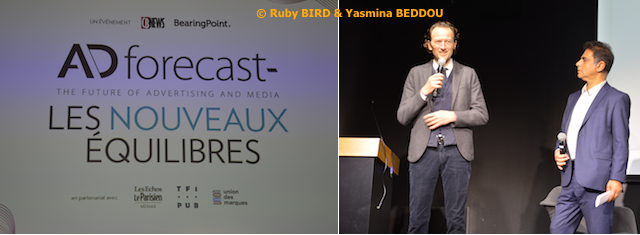Business
AD FORECAST - THE NEW BALANCES -
THE FUTURE OF ADVERTISING & MEDIA

Nicolas REFFAIT & Frank PAPAZIAN ** (Source: © Ruby BIRD & Yasmina BEDDOU)
USPA NEWS -
Communication is more diverse than ever, whether it’s personal discussion with friends, family and colleagues or a large brand’s messages to a consumer base. The mainstream introduction of the internet in the early 1990s brought new and exciting communication methods. These advances in technology paved the way for digital media to have a major influence on how businesses and brands create relationships with their customers. They have also impacted traditional communication professions.
Communication is more diverse than ever, whether it’s personal discussion with friends, family and colleagues or a large brand’s messages to a consumer base. The mainstream introduction of the internet in the early 1990s brought new and exciting communication methods. These advances in technology paved the way for digital media to have a major influence on how businesses and brands create relationships with their customers. They have also impacted traditional communication professions.
The future of media is continuing to turn to digital advances for entertainment, news, and business, which translates to major opportunities for businesses. Innovation is the new norm when it comes to media, and that trend isn’t likely to change as we look to future media concepts. Social media, digital advertising, and increased access to the internet through various devices have all shaped trends in media. The future of digital media will evolve as new tools emerge, consumers make new demands, and the quality and accessibility of the technologies improve. The rise of mobile video, virtual reality (VR), augmented reality (AR), and the more refined use of data analytics will all influence the future of digital media.
The use of digital media in personal and professional communication has been accelerating at breakneck speed in recent years, and the COVID-19 pandemic has kept that momentum going. Lockdowns, concerns of infection, and restrictions on in-person commerce have all pushed people to more online use. The swiftly changing market landscape and ongoing diversification make it difficult to make long-term predictions about the future.
What will the future of TV and video look like in a few years' time? Will global platform giants such as Netflix, Amazon, Apple, and Google dominate the market? Or will the TV and video industry develop into a diverse ecosystem shaped by cooperation, in which traditional providers also have a role to play?
TV and video advertising is adapting to new formats and relying more and more on the personalization of advertising content. The analysis of user data makes it possible to optimize ads and content, increase the benefit for potential customers, and ultimately to win them over as consumers. To secure their business models and future revenue streams, they must open themselves to cooperation and alliances, including with direct competitors. Joint production, joint distribution models, and even joint platforms are suitable ways of countering the threat from digital platform providers such as Netflix, Amazon, Apple, or Google.
Like many markets or professional fields, media markets operate under many regulatory authorities and laws with the aim of limiting liberal economy and free competition. These laws aim at not only regulating business and economy but also professional ethics or practices. Market structure of press, radio, and TV is historically characterised by the pivotal role of the central state and its linked organisations.
The Superior Audiovisual Council (CSA) is the regulatory authority responsible for the audiovisual sector. The CSA sets rules on broadcasting content and allocates frequencies by granting licences to radio and television operators. It also settles disputes that may arise between TV channels and their distributors, and is empowered to impose sanctions on operators in cases of breaches of specific regulations.
The High Authority for the Distribution of Works and the Protection of Copyright on the Internet (HADOPI) is in charge of protecting intellectual property rights over works of art and literature on the internet. An audiovisual reform originally planned for early 2020 including the merger of the CSA with the HADOPI has been pushed back until now (due to the health crisis of covid-19)... The flagship measure is the creation of the Audiovisual and Digital Communication Regulatory Authority (Arcom).
The impact of the pandemic on the digital media and gaming sector has predominantly been positive as there has been an increased demand for digital content, new technologies and apps (eg home schooling, wellbeing and food delivery apps), games, esports and virtual and augmented reality products. Businesses within the sector may be in a unique position to grow and expand further, attract new customers and shape the New Normal.
The concept of subscription retail is no news – it has always been present, even way before the digital commerce boom. Newspapers and magazines have been doing it for years and with the rise of streaming apps like Spotify and Netflix, the subscription culture shifted to almost everything. From groceries to beauty items, books to snacks and other replenishment products, it is safe to say subscription-based businesses are on the rise. As well as other online services, retail subscription services were boosted by COVID-19.
With a shift in customer behavior and big economic changes, customers want discounts and sellers want to sell. This new sales model often includes innovative ways to reach audiences and keep the dialogue going beyond the initial sale. The new economy of subscriptions for Convenience Store Retailers will create recurring customer revenue, brand loyalty, and greater profitability.
* Photo (R)
- Fabien MAGALON, Chief Publishing Sales Officer at OGURY
- Philippe BOSCHER, Deputy Marketing Director at TF1 PUB
- Mykil CHIKLI, CEO EMA at WEBORAMA
- Fabien MAGALON, Chief Publishing Sales Officer at OGURY
- Philippe BOSCHER, Deputy Marketing Director at TF1 PUB
- Mykil CHIKLI, CEO EMA at WEBORAMA
One problem with cookie technology is security concerns: hackers can easily intercept users’ data to hijack their accounts if the browser sends cookies over unencrypted connections. As the number of account hijacking cases is growing over time, the flaws of browser cookies are sparking an ongoing controversy about this technology. To respond to these concerns, modern web browsers started a crusade against cookies, resulting in browser-level blocking, third-party ad-blocking apps, and stricter regulations. Now, cookie technology is gradually being phased out by browsers and governments alike. However, marketers still need to carve out a way to identify individual users and track website visitors’ data.
ADFORECAST 2021 "THE NEW BALANCES" Event was held on October 20, 2021 @ Headquarters of Les Echos - Le Parisien (Paris).
Animated by Emmanuel CHARONNAT (Director CB Expert)
Welcome Speech by Franck PAPAZIAN (President Mediaschool) and Nicolas REFFAIT (BearingPoint Associate)
Introduction by Pierre LOUETTE (President Les Echos)
Presentation of the New Body ARCOM which is the merger of CSA & HADOPI, by Roch-Olivier MAISTRE (President CSA)
- Conclusion by Jean-Luc CHETRIT (General Manager Union Des Marques)
Animated by Emmanuel CHARONNAT (Director CB Expert)
Welcome Speech by Franck PAPAZIAN (President Mediaschool) and Nicolas REFFAIT (BearingPoint Associate)
Introduction by Pierre LOUETTE (President Les Echos)
Presentation of the New Body ARCOM which is the merger of CSA & HADOPI, by Roch-Olivier MAISTRE (President CSA)
- Conclusion by Jean-Luc CHETRIT (General Manager Union Des Marques)
The Event was carried out under the following Themes:
- The Advertising Market: To Foresee is to Act
- Media Industries: The New Points of Balance
- RSE and Brand Values: Stimulus Engines?
- The Challenges of Data at the Era of Cookieless
** PHOTO COVER
Introduction speech
- Nicolas REFFAIT Associate BearingPoint
- Franck PAPAZIAN CEO Mediaschool
Ruby BIRD
http://www.portfolio.uspa24.com/
Yasmina BEDDOU
http://www.yasmina-beddou.uspa24.com/
- The Advertising Market: To Foresee is to Act
- Media Industries: The New Points of Balance
- RSE and Brand Values: Stimulus Engines?
- The Challenges of Data at the Era of Cookieless
** PHOTO COVER
Introduction speech
- Nicolas REFFAIT Associate BearingPoint
- Franck PAPAZIAN CEO Mediaschool
Ruby BIRD
http://www.portfolio.uspa24.com/
Yasmina BEDDOU
http://www.yasmina-beddou.uspa24.com/
Ruby Bird Yasmina Beddou Cbnews Les Echos Le Parisien Market Media Values Brands Strategies Customers Content
Liability for this article lies with the author, who also holds the copyright. Editorial content from USPA may be quoted on other websites as long as the quote comprises no more than 5% of the entire text, is marked as such and the source is named (via hyperlink).















